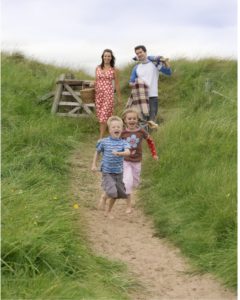Kids & Teens
Chefs Move to Schools
The School Nutrition Association (SNA) and the Chefs Move to Schools program—part of First Lady Michelle Obama’s Let’s Move! Initiative—recently partnered to support SNA member schools’ efforts to promote healthy school environments.
Go Screen-Free!
Turn off the tube and enjoy some quality time with your children during Screen-Free Week (April 30–May 6), an annual event in which families, schools and communities leave all screens dark. Reports suggest that preschoolers spend an average of 32 hours a week in front of the television or a computer screen, and older children spend even more time there. Excessive screen time can lead to poor school performance, childhood obesity, attention problems and reduced creative play.
Making Kids’ Food More Appetizing
Kids adopt their parents’ preferences on many fronts, but when it comes to how food is presented on a plate, children have definite opinions, and these impact what they eat. According to a study published in the January issue of Acta Paediatrica (101 [1], 61–66), the nut definitely falls far from the tree when it comes to plating.
Mindfulness Practice: Empowering Fragmented Teens to Become Whole
When 18-year-old K. attended an Insight Meditation Teen Retreat, she was seeking answers, reaching for help, trying to make sense of her pain and suffering. A college-bound Caucasian student from a comfortable middle-class suburban setting, K. had begun self-harming. Knowing it was wrong and starving for guidance, she immersed herself in an intensive 4-day residential mindfulness meditation program.
Childhood Obesity and Overweight Rates Drop in California
Plenty of focus has been placed on the increasing prevalence of overweight and obesity among children and adolescents. But it appears that in California the scales have tipped in the other direction—if only slightly.
Teen Diets:Fiber Over Fat
A recent study concludes that higher intakes of dietary fiber—but not low intakes of saturated fat or cholesterol—are related to lower risk of metabolic syndrome in adolescents. The authors suggest that to reduce metabolic syndrome—a collection of risk factors that include high blood pressure and a large waistline—it is more important to emphasize fiber-rich, nutrient-dense, plant-based foods than to focus on restricting foods high in cholesterol or saturated fat.
When Children Sleep Impacts Health Outcomes
Getting enough rest at night not only helps kids feel rested and alert; it contributes to better health as well. But a recent study suggests that when children sleep can also impact health and physical activity levels. A study of 9- to 16-year-old Australians found that adolescents who were “early to bed and early to rise” were less likely to be obese than night owls who woke up later. Night owls logged 2.9 times more television and computer screen time. They also replaced about 30 minutes of physical activity with 30 minutes of inactivity, compared with early sleepers.
Initial Research on Mindfulness Programs for Teens Shows Promising Results
Emerging research suggests that mindfulness is feasible and acceptable for youth and may also be beneficial to them (Burke 2010). Qualitative, quantitative and randomized clinical trial studies show that teens accept mindfulness-based programs and do not experience any adverse effects from them. Studies also show that mindfulness approaches are producing benefits in teens in the form of more feelings of well-being, less anxiety and worry, and less emotional reactivity (Burke 2010).
The Workout Kid
Another individual who has undertaken the challenge to Inspire the World to Fitness® is affectionately referred to as “The Workout Kid.” At only 10 years old, CJ Senter has joined the ranks of fitness professionals in helping kids his age find the fun in fitness. He even has his own DVD fitness series that consists of two 40-minute workouts.
Sports Participation Improves Behavior in Boys
A positive introduction to sports at a young age can set the tone for a healthy life. According to findings presented at the Renata Adler Memorial Research Center for Child Welfare and Protection Conference, hosted in Israel by Tel Aviv University, boys who play sports see improvements in self-control and discipline. The 24-week study included 649 children, in grades 3–6, from low socioeconomic backgrounds. Half the students participated in a sports-based afterschool program, the other half in a nonsports afterschool program.
children’s cereal labels mislead parents
Not everyone has impeccable food knowledge, so when a sugary cereal touts itself as being whole grain, fortified with essential vitamins or otherwise good for your child’s health, you may believe it, toss the box in the cart and move on with your shopping trip with some assurance that the product must be okay. Not so fast.
Teens Avoid PE
Fitness professionals are well aware of the many threats that obesity poses to the health of our children. Traditionally, we could count on schools to help curb this problem by providing daily physical activity through physical education (PE) classes. Times have changed, however, and we may need to start looking for other avenues for upping daily exercise for teens. According to the Adolescent Physical Education and Physical Activity in California report, only 42% of the 6 million students enrolled in California schools participate in daily physical activity.
Physical Activity Recommendations for Toddlers?
The United Kingdom recently released its public health guidelines for physical activity. For the first time, the publication includes recommendations for those under 5 years old. The guidelines are based on research that supports the benefits of adopting healthy behavior in early years.
According to the report’s authors, “These guidelines reflect a growing awareness that early life experiences impact upon future health outcomes, and draw on notable recent advances in the science of physical activity and health.”
high-calorie and high-sodium items most prevalent in kids’ fast-food choices
Kids may like the food, and parents may appreciate the convenience, but are the poor nutritional consequences of fast food worth it? A recent study by University of California, San Diego (UCSD), pediatrics researchers showed that fast-food lunches accounted for 36%–51% of a child’s daily caloric needs, with fat contributing 35%–39% of the calories. The meals also provided more than 50% of the recommended total daily sodium intake for most children—and as much as 100% of sodium levels recommended for preschoolers.
GeoPalz Gets Families Moving
September is Childhood Obesity Awareness Month. Help inspire the younger generations to become more active and fit with GeoPalz, an online fitness tracking website that offers rewards based on daily steps taken. A husband-and-wife team created the site to encourage their own kids to get moving. Children simply wear a pedometer to count daily steps taken, and then log the total each day. After logging a certain number of steps, a child is eligible to receive an activity-oriented prize such as a soccer ball or a Frisbee®.
Body Image Issues Affect Youth
A recent study published online ahead of print in the Journal of Clinical Nursing (2011; doi: 10.1111/j.1365-27022011.03739.x) uncovered troubling evidence that children as young as age 10 engage in self-induced vomiting in order to lose weight. The survey included 15,716 Taiwanese boys and girls aged 10–18 from 120 schools. Each participant was asked to complete a survey that included questions on topics such as physical activity, diet, sleep, sedentary behavior and self-induced vomiting and dietary behaviors. School nurses then measured each student’s height and body weight.
Overweight at 18 Increases Cancer Risk
Here’s another bit of news to help encourage overweight men to drop the extra pounds. A link has been found between excess weight in 18-year-old males and increased risk of cancer-related death later in life. The Harvard Alumni Health Study cohort involved 19,593 males who had had physical examinations when they were 18. The men then submitted follow-up questionnaires at age 45, with a final vital status follow-up at a maximum of 82 years. After analyzing the data, researchers learned that 2,395 of the men had died of some form of cancer.
Candy and Obesity: Are More Treats Good for Kids?
Is eating more candy an anti-obesity strategy? That would have Willy Wonka dancing a jig with the Oompa Loompas and the rest of the candy industry.
A controversial study from Louisiana State University published in the peer-reviewed Swedish journal Food & Nutrition Research (2011) showed that kids and adolescents who ate candy were significantly less likely to be overweight or obese.
Sprints Improve CVD Risk Factors in Youth
Experts believe that physical activity participation in youth can promote good health into adulthood. According to a recent study, one way youngsters can reduce cardiovascular disease (CVD) risk factors is to participate in brief periods of high-intensity exercise (HIT). The study subjects included 47 boys and 10 girls who were approximately 16.4 years of age. They were separated into three groups: high intensity, moderate intensity and control.
Sprints Improve CVD Risk Factors in Youth
Males concerned with fertility might want to step off the bike and supplement with other forms of physical activity. A report published in Fertility and Sterility (2011; 95 [3], 1025-30)…







